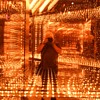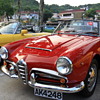Posted 12 years ago
 rniederman
rniederman
(349 items)
This is an early cabinet card nude-study with 42 'gem' size images of a young woman in various [non-erotic] poses. In nearly 30 years of collecting, this is the only such card I've seen.
Although there is no information about this nude study, the albumen paper more than likely dates the card to the 1880s (maybe earlier but I don't know); about the same time Eadweard Muybridge was creating his famous animal locomotion studies (which included models who were nude, seminude, or draped in a thin fabric). Yet the images are not similar to Muybridge's work because the young woman isn't shown in a sequential motion.
**************
Update (2020-03-19): While studying auctions including very early photographic images, I came across one particular auction Lot featuring a photographic album of female nude studies by the French photographer Louis Jean Baptiste Igout (1837-1881). I was amazed how the examples shown in the auction Lot were remarkably similar to the cabinet card posted here. Looking more closely, I discovered several images exactly match pictures on my cabinet card. The notable difference is that my cabinet card has 42 individual pictures attached to a cabinet sized card as opposed to the auction house’s “composite” images; which are re-photographed pictures printed as a single albumen image on a larger mount. Further searching uncovered many more auctions featuring Louis Jean Baptiste Igout nude studies. After all these years, I am happy to now have a strong attribution to the artist and cabinet card age.

































Rob, I'm really puzzled as to how this was done; a multi-lens camera would take the same shot multiple times on the same negative. How did the gem cameras work? They seem to have been an American speciality.
Thanks mustangtony!
Thanks, Eric!
As background, the term 'gem' refers to an image format that is smaller than a 'bon ton'. Yet there is no standard size for gem images. Therefore, any camera capable of making very small images can be said to shoot 'gems.'
It is true that a multi-lens camera would create many of the same image on a single plate. However there are single lens multiplying cameras that used shifting backs to make numerous gems on a single plate. (Some multi-lens cameras also had shifting backs.) Each picture (or groups of images) was shot separately. Different pictures were then made by shifting the back (vertically and/or horizontally) to expose another part of the plate.
Simon Wing's famous studio cameras could do this. My collection also includes several cameras with the ability to make multiple individual images on a single plate: Schaub, Wing Ajax, Stock, Anthony Climax Multiplying Camera, and a Montauk Flexo-Front.
The number of images per plate depends on the registration hardware. For instance the Schaub can make 36 images on a 4x5 plate while the Wing Ajax can only do 15 on a 5x7 plate ... you get the idea.
Hi Rob,
As you are aware, I have been around old cameras for a long time, and I have seen nothing British of this kind. It is either a purely American phenomenon or I haven't been looking in the right places. I have seen repeating backs for normal half-and whole-plate cameras, but only for two or three images, never multiples like these. I see from the internet that the multiplying back was an American patent of Southworth, purchased by Wing. Some cameras of this type must have migrated to this side of the Atlantic, but I have seen none.
We learn something new every day.....
Regards,
Eric.
Thanks, officialfuel!
Thanks walksoftly and blunderbuss2!
Thanks, Phil!
Thanks, Sean!
Hems303 - thanks for the 'love' and comment. I like your point of view.
What's odd is that the images on this card are very small (gems). What I typically see is a single large image. For instance, I have two wonderful French cabinet cards; each with a single image of a classically posed nude figure [study]. Unlike this multi-image card, the French cabinet cards also have identification and are beautifully produced. Maybe they are tasteful enough to post on CW.
I have seen SIMILAR photos before. Usually done as a photo of a photo (or group of photos). The individual gem size images adhered to the card is different.
I believe these were done to show the stock of available images. Point to the one you want and the photographer wiould sell you a cabinet card sized version of that particular image.
scott
Hi Scott ... thanks for looking and the comment.
Your idea has merit. As we know, photographers have stock images on hand for reordoring (i.e. from CDVs and such). The images shown here have a lot of detail and look like contact prints as opposed to photos of photos. So based on your suggestion, this could be a convenient reference of stock poses for customers who want (for example) boudoir style photos.
Regardless if these are figure studies or references to stock images (and so forth), you and Hems have brought up some interesting ideas. Thanks.
Rob
Thanks ho2cultcha and collector4evr!
Thanks, leighannrn!
Eric; in regards to your comment (#5), I cannot attest to English multiplying cameras but Disderi created a multi-lens apparatus around 1860 that was able to shoot different images on a single plate. The George Eastman House has a fine example of the camera and a multi-image plate.
Thanks Rob..........as I said before, something new every day!
Thanks, trukn20!
Thanks, Designer!
Thanks, sanhardin!
I have never seen one like this until this one, nice, Hardbrake
Thanks, Hardbrake!
Thanks, Longings!
Thanks, AmphoraPottery!
Thanks, kindy!
Thanks, filmnet!
Thanks, Sean!
Thanks, geo26e!
Thanks, tom61375!
Thanks, valentino97!
Thanks, aghcollect!
Thanks, pops52!
Thanks again, ho2cultcha!
Thanks, Moonstone!
Thanks, PostCardCollector!
Thanks!
ho2cultcha
Brunswick
MALKEY
I finally discovered the name of the photographer of this cabinet card: Louis Jean Baptiste Igout (French, 1837-1881). I added new information above. After all these years, I am happy to now have a strong attribution to the artist and cabinet card age.
Thanks, kwqd!